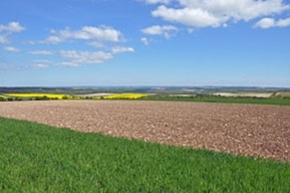 Lapwing, once a common bird on farmland, have declined hugely (45%) since 1970 and they are now a “red list” species. One of the main factors behind the decline has been the widespread switch from spring-sown to autumn-sown crops since the 1970s, which has dramatically reduced habitat suitability for nesting.
Lapwing, once a common bird on farmland, have declined hugely (45%) since 1970 and they are now a “red list” species. One of the main factors behind the decline has been the widespread switch from spring-sown to autumn-sown crops since the 1970s, which has dramatically reduced habitat suitability for nesting.
Uncropped, cultivated land can provide suitable nesting and foraging areas and were previously supported under Countryside Stewardship. These areas are also used by a variety of other farmland birds that prefer to forage in open ground (skylark, stone curlew, turtle dove), by hares and encourage annual arable plants.
Each uncropped plot must be at least 1ha (no greater than 2.5ha) and located within an arable field of at least 5ha. Ground nesting birds are very vulnerable to predatory birds such as crows, magpies and gulls. It is therefore crucial to site the plots away from any feature (trees, posts, pylons) that can be used as a perch by these predators to overlook the plot. They must also be located away from field edges to reduce predation by foxes and only in fields larger than 10ha if bounded by trees.
They are created by cultivating in early spring (20 March at latest) to produce rough fallow. Plots can be rotated around the farm, so helping to reduce the build-up of pernicious weeds, but the same hectarage must be maintained each year. Undesirable weeds can be controlled with herbicides prior to making the rough fallow. Plots must be maintained until the 31 July.
Lapwing take their young to forage in vegetation that provides some cover, ideally rough grassland that provides a rich source of their preferred food (insect larvae, beetles, worms). Chick survival will therefore be improved if the uncropped plots are located near to such foraging areas. Alternatively, if sufficient vegetation develops on the uncropped plot then this may be suitable. We are currently investigating whether sowing a suitable cover will improve chick survival.
*You may change your mind any time. For more information, see our Privacy Policy.